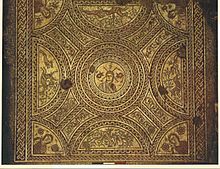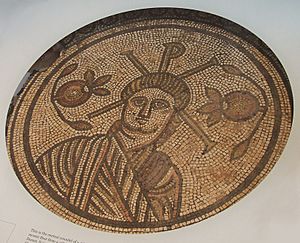Hinton St Mary Mosaic facts for kids
Quick facts for kids The Hinton St Mary Mosaic |
|
|---|---|
 |
|
| Material | Ceramic |
| Created | early 4th century |
| Period/culture | Romano-British (Christian) |
| Place | Hinton St Mary villa, Dorset |
| Present location | G49/wall, British Museum, London |
| Registration | 1965,0409.1 |
The Hinton St Mary Mosaic is a very old and large Roman mosaic. It was found in a village called Hinton St Mary in Dorset, England. This amazing artwork is special because it seems to show a picture of Jesus Christ. This picture is the main design, or motif, in the middle of the mosaic.
The mosaic was so important that it was featured on a BBC Radio 4 show. It was Object 44 in A History of the World in 100 Objects. The show was presented by Neil MacGregor, who was the director of the British Museum.
This mosaic covered two different rooms. A small decorated area connected them. The mosaic mostly uses red, yellow, and cream colors. Experts believe it was made in the early 4th century. It was likely created by artists from a workshop in Durnovaria, which is now Dorchester. Today, the mosaic is kept at the British Museum. You can see the main part of it on display there.
Contents
Discovering the Christian Panel
The biggest part of the mosaic is in the larger room. It measures about 17 by 15 feet (5.2 by 4.6 m). In the very center, there is a round picture. This picture shows a man wearing a white cloak, called a pallium. Behind him is a Christian symbol called a chi-rho. This symbol looks like a P with an X through it. Two pomegranate fruits are on either side of the symbol.
Most people think the man in the picture is Jesus Christ. However, some have wondered if it could be the Emperor Constantine I. But there are no special signs to show it's an emperor, only the chi-rho symbol.
Around this central picture, there are four half-moon shapes, called lunettes. Each of these shows scenes from a forest. They mostly feature dogs hunting deer. In the corners of the mosaic, there are four quarter-circle pictures. These might show the Anemoi, who were gods of the winds, or they might show the four seasons.
Exploring the Pagan Panel
The mosaic in the smaller room is about 16+1⁄2 by 8 feet (5.0 by 2.4 m). It also has a round picture in its center. This picture shows a story from Roman mythology. It features Bellerophon fighting and killing the Chimera. The Chimera was a monster that was part lion, part goat, and part snake.
Even though this story is from pagan myths, some people think it has a Christian meaning. They believe it shows good winning against evil. On either side of this central picture, there are two rectangle-shaped panels. These also show dogs hunting deer, similar to the larger room.
The Mosaic's History and Location
The Hinton St Mary Mosaic was found on September 12, 1963. A local blacksmith named Walter John White discovered it. The Dorset County Museum helped to clear the area around it. Then, the British Museum carefully lifted the mosaic to keep it safe.
No other parts of the building where it was found have been explored. People generally think it was part of a Roman villa, which was like a large country house. The way the mosaic room is set up looks a lot like a Roman triclinium. This was a dining room where people would recline on couches while eating. However, it's also possible it was a church or another Christian building. No items found at the site were older than about c. 270.
Moving the Mosaic
In the year 2000, the British Museum built a new roof over its open courtyard. As part of this big building project, they decided to move the Hinton St Mary mosaic. The mosaic was stuck to the museum floor. Workers had to carefully lift it up, and it broke into pieces.
Now, these pieces are stored in boxes deep inside the museum. Only the central Christian picture is still on display in one of the museum's galleries.
See also
 In Spanish: Mosaico de Hinton St Mary para niños
In Spanish: Mosaico de Hinton St Mary para niños


